On Ploughing for the Future
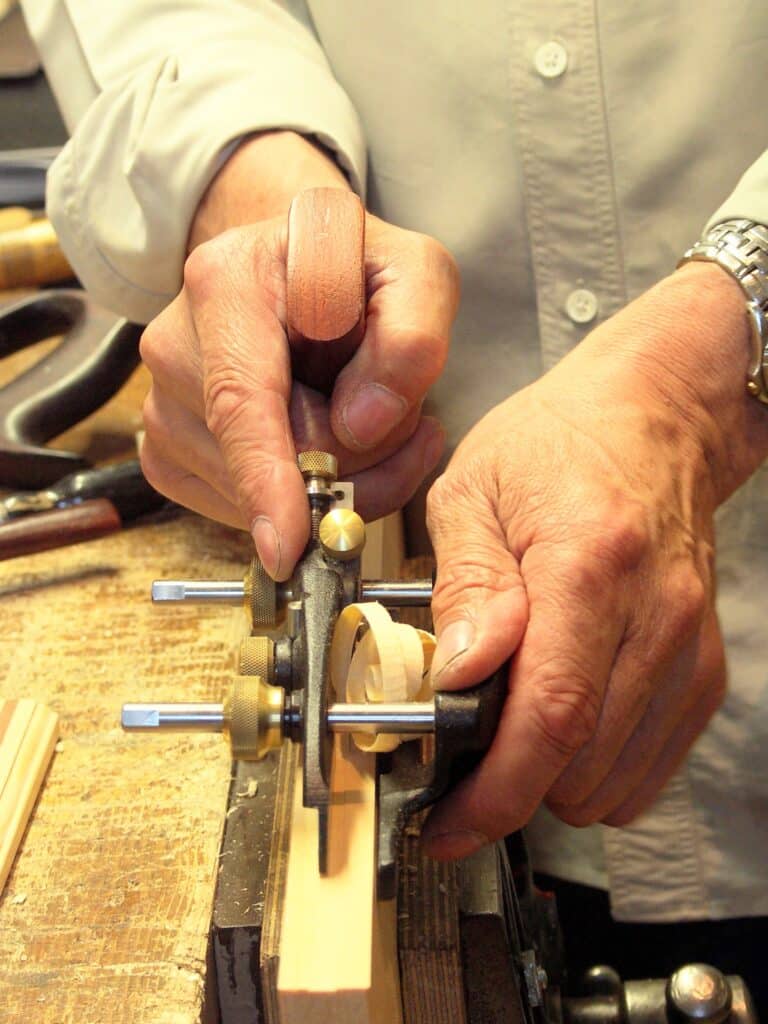
Can a basic plough plane create what you want from your woodworking? A moulding plane, perhaps? A #78 rebate (rabbet) plane, or a side rebate plane? I’ve been using them alongside machines throughout my life but it was only when I saw how easy machining is in not just replacing them but more displacing them and so prioritising machine methods as a preferred way of working. It makes it so easy to say, “Ah! That’s what I need, not hand tools!” I completely understand! The press of a button, the flick of a cammed lever, quick lockdown of a fence and the job only needs a bit of a periodic nudge as you pass the wood into and through a cutterhead of one kind or another. What is there not to want with such equipment? I used my first saw machine with a 20″ circular blade when I was 16. I was too young, much too young. Things did go wrong and I was not altogether equipped for such machinery. The company I worked for provided zero personal protection equipment, no dust extraction was anywhere on the radar and if I wanted a dust mask I had to go buy a surgical mask from the local pharmacy at my own expense. The saw and other equipment had no mechanical blade covers and I was handling 10-12 footers of 10″ by 4″ on my own to feed into the machines. The jointer was 24″ wide and one slip would have taken my arm off to the shoulder in less than a few seconds. My weight? About half what I am now, I guess.
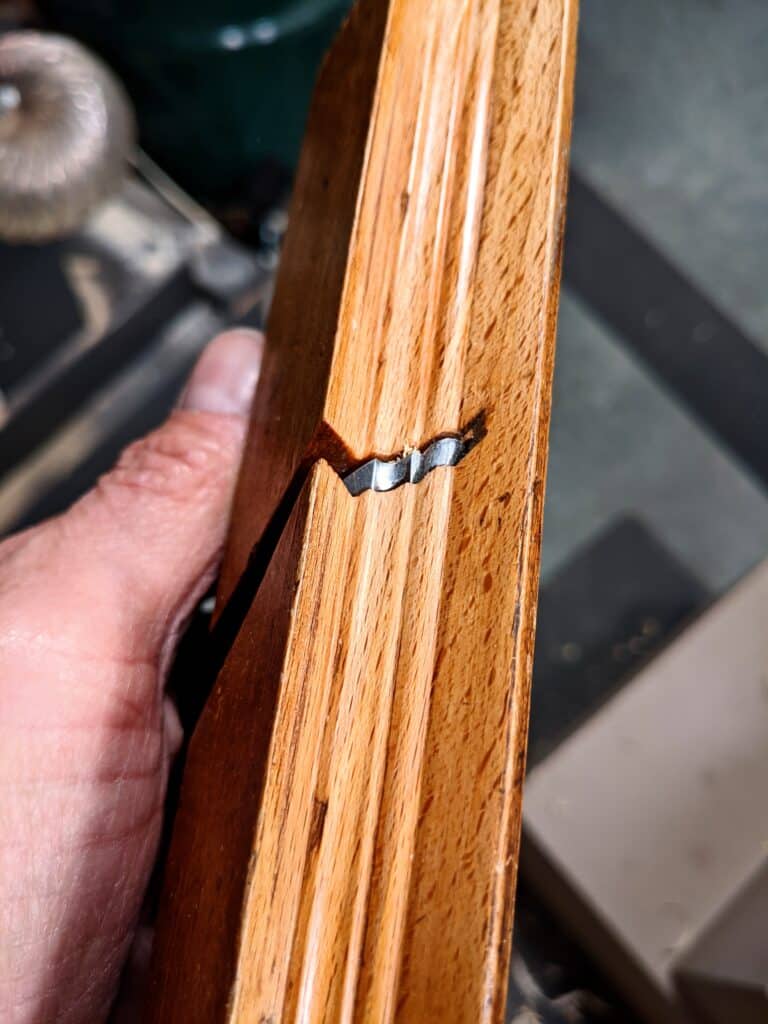
Of course, I gained confidence the more I used the different machines. And then one evening my dad said, “I hear you are using big machines now.” I said I was and he pointed to his little finger with its terrible disfigurement throughout the nail. “I did this on a swing saw.” he said. This swing saw, sometimes called a drop saw, hung from a fixed point above a bench and was dropped to cross-cut beams of wood. His had no guards. He woke me up to my original fears and ever since then the picture of his finger pops up when I use a machine. It was two decades before I caught my finger in a tablesaw blade and hit the bone through my fingernail. It came at the time when I was on production making hundreds of walking canes a week and in an unconscious moment, my finger shot off at a tangent and caught the tungsten teeth. I had had near misses at different points in my life and of course, the more you use machines the more you are likely to have things happen. It’s important to note that even with all guards in place and with a saw that stops in a millisecond, things can and will happen when you did nothing wrong. Wood can split when and where and in ways that you would never expect. You are pushing, the blade releases tensions in the wood and parts curl in a split second and a two-horsepower thrust can lift and divert a balking section of timber in a way you could never forecast. Before you know it you are on your own on the floor with a shard of tungsten shooting through your thumb, your arm or your chest. How do I know? These things have happened either to me or in my presence. In some cases, no one did anything wrong and in others they did. These things are worthy of note when you press the button in your basement to make that last pass over the cutterhead.

I was 40 when I decided to make a more complete switch in my future world of woodworking. I would say that at that time I knew no one that used hand tools anywhere although I did know one woodcarver carving western scenes on headboards and plaques and such. Many professionals carried a plane for remedial work but would more likely reach for their belt sander and power planer and not the hand plane. I saw how, in general, living in the USA, people I knew well as carpenters and furniture makers used every machine type you could think of. In the backs of their trucks and vans, there really were no hand tools beyond a chisel and a hammer, a pinch bar and maybe a screwdriver, a pencil and a chalk line in a pouch. It wasn’t at all different in workshops too. Hand tools were usually covered in dust on an equally dust-laden and dark shelf somewhere, a token relic or two from the past, mostly. Again, I understand how and why this happened. Deskilling is common practice throughout all crafts and trades but we now attribute skill to being able to operate a machine and in some ways that is true in that working the computer itself, developing plans and systems digitally is the different skillset people now acquire as the current alternative. And why not? Isn’t technology supposed to make life easy? Power-feeds, Amazon, YouTube instruction, AI and such?
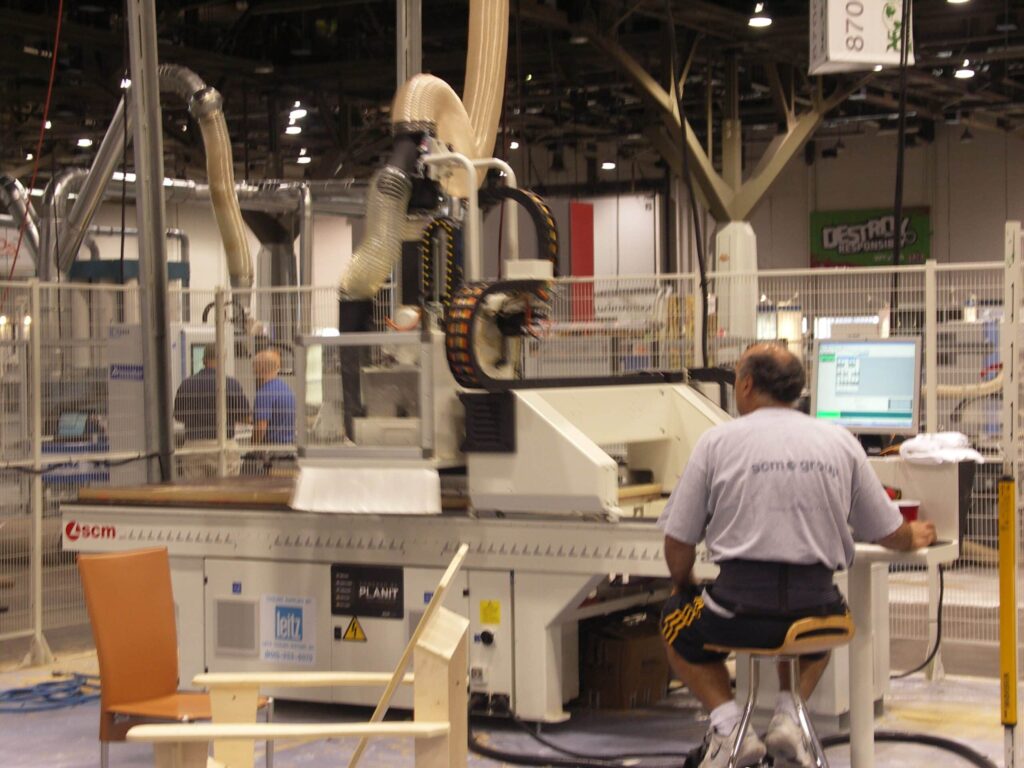
What others called the ‘progressive way forward’ made me rethink what woodworking really means. What does it mean for me as a maker of single items and small batches rather than mass-making of any kind? Stepping away from my mass-making walking canes, sticks and staffs put me on a new trajectory even though at times my wages were halved and even quartered. For some of us, the journey with hand tools becomes a clearly defined path and not in any way negative but progressive. It’s a path and passage leading to life and living a way that seems so alien to so many yet to me and to others the journey of making by hand now means at least as much if not more than even the completion of the project itself.
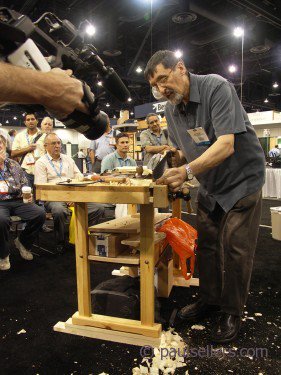
My seeing a way forward for hundreds of thousands of others starting out on their woodworking journey began by my own decisions to disengage from what had become the status quo and to actually take ever-greater control of my life. I cannot say it was a preconceived plan so much as an unfolding one where I saw a less trodden pathway. I did however see it as a path I felt was more the real woodworking I personally desired. As people clustered around to listen to the sales pitch of machine salesmen, my workbench held equal sway with many who actually found what they were looking for in a cluster of hand tools and man that knew exactly how to use them and without selling anything. Over many years it became ever-more obvious that I was not as alone as I thought I was. Who would have thought that my cutting a twin dovetail in half-inch pine with a gent’s saw could change the course of life for thousands of others? In my ‘evangelising‘ at my workbench, and I did this dozens of times each day of the woodworking events, I would make converts in just a few minutes. Often, with dozens and even hundreds circling me, and using TV screens beyond my reach, I could show people just how very effectively hand tools worked. What was common to me had become a rarity and watchers were mesmerised. They somehow believed that what I had adopted with hand tools was totally possible for them to adopt too. More so, perhaps, than any other way for most of them. Suddenly the concepts of hand-making with hand tools became a real option. No longer the one-way machine path, they had a direct comparison that would deliver the end results with a journey into skilfulness they could now take pride in. I told them how I could sharpen my saw in a few minutes and that they could do the same with just a little push and a bit of practice. I’d take out my diamond plates and sharpen a plane and a chisel in front of them and then let some of them try my plane, yet guess what? I wasn’t even selling anything back then. Not classes. Not tools and I wasn’t even getting paid for demonstrating either.
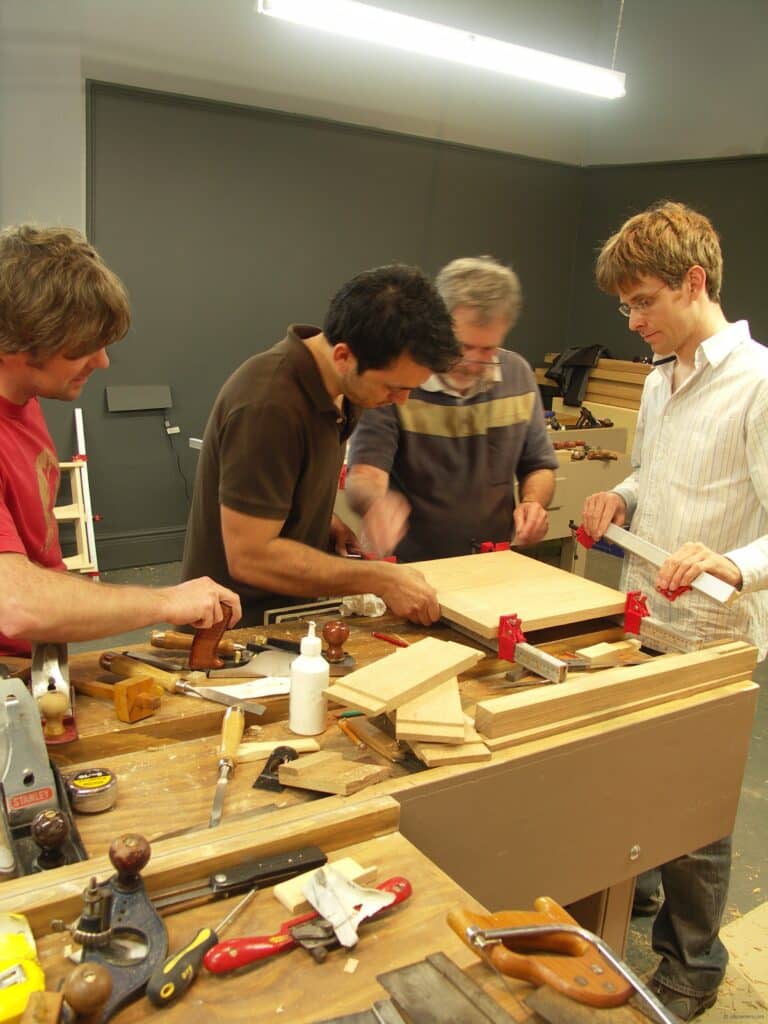
While still being open to other options as long as they were safe, my way was more available to all anywhere in the world and becoming all the more so. One by one, they could see how they too could skillfully work through the different projects they wanted to make. I think many watching my work grow through the decades may not know of the raw beginnings traveling state to state and show to show. It was hard and it was fun. It was expensive and I had no money and made none either. No one can ever accuse me of taking easy paths. That flat tyre in the middle of winter in the middle of nowhere on my way to Reno, Nevada from Willow City (population 13), Texas and the snow falling many inches deep and I, all alone, at 10pm. And who carries a spare tyre (tire USA) for their U-Haul trailer anyway?
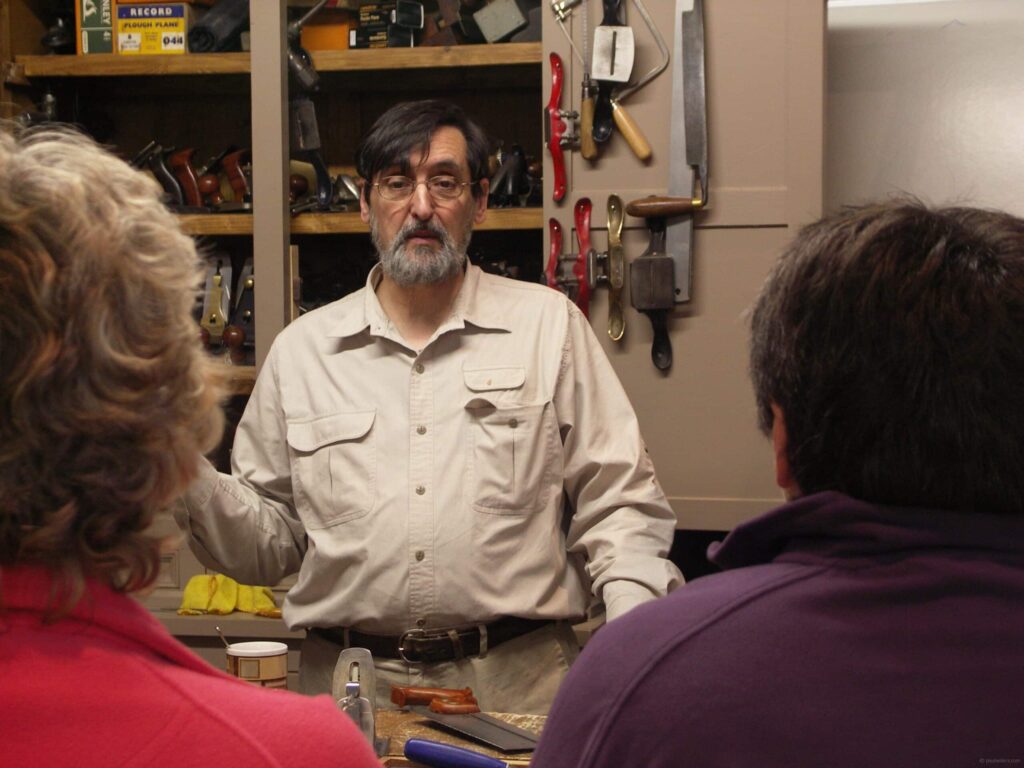
With the exception of the bandsaw, I have now proved well enough that while handwork does often take longer, it can also speed up many a process too. In my world, hand tools mean a good and general physical and mental workout, continual development and exercise, and much more, more than I can ever get from machining and indeed much more stimulating and less boredom. At 72-years of age, this hard labour gives life to my aging body, and it’s just plain good for me. I credit my non-aching body to the workouts I get in working the way I do every day. On Thursday I planed wood by hand for five solid hours. I felt great! Yesterday I did about the same. What the NHS recommends as exercise for septuagenarians in a week, I do several times in every given day just woodworking and without my other exercise too.
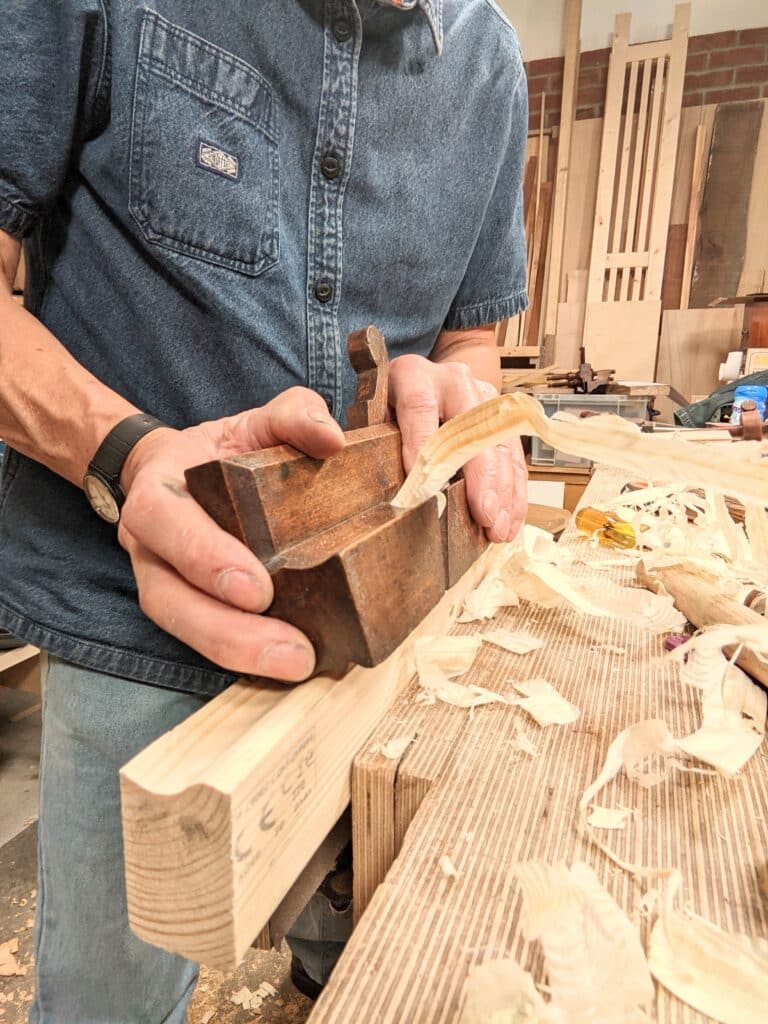
Some years ago, nope, decades now, I saw the writing on the wall for young people and I spoke out about it at the time. Standing inside a workshop where boys and men lined up to use a bandsaw to cut out some basic shapes and I felt grieved by the evident boredom and that they were setting coordinates for the children that said the only way for shaping was a machining experience. I know. Who owning a bandsaw wants to cut out with a coping saw? But the problem was it was the dads cutting out the shapes and not the kids. You cannot responsibly put children on bandsaws and please, don’t those of you who say your kids used a bandsaw at eight comment that your kids did! The same thing happened when I saw a man sweep down the side of a felled tree with a chainsaw to trim off small branches as a prep-step for slabbing the tree into boards. The kids standing around were mesmerised by the speed of it, yes, but how much more would they have enjoyed using a branch saw and cutting them off themselves. We can do the same when we stand children around a machine that rips down a billet of wood to make a slimmer piece fit the size we want. Truth is though, we can be setting their coordinates for a machining future rather than a hand tool world that they might just love. I have lived through these different worlds, united them and then regretted it. If you take your kids to watch machine methods only then they must wait until they “come of age” before they too can become woodworkers by using such equipment. This for me is total sadness. Why? Kids love the idea of making things with their hands and with hand tools. I have yet to meet any person under the age of 18 years and all the way down to under three who balked at using a hand tool I handed to them to have a go. When each of my boys was around three I handed them a spokeshave and a section of wood and they shaped it into a spatula, a spoon or a cutting board.
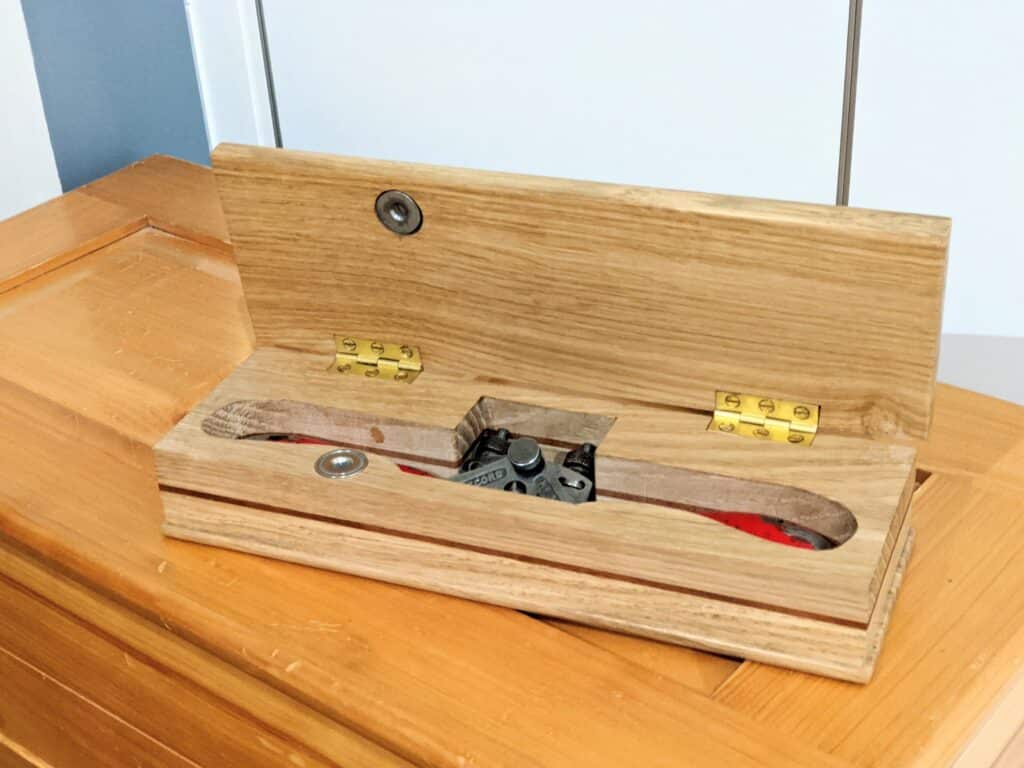
I recently, six months ago, handed my old Marples spokeshave to my 2 1/2-year-old granddaughter to fashion the same spatula her father and I made over 30 years ago. In the same fashion, I perched her atop a wooden platform base so that she could reach the benchtop and the vise and so she followed in his steps learning about wood and spokeshaves and possibly taking the steps he took to becoming a violin maker. She (and I) shaped and shaved the wood until a spatula emerged from the shavings and she took it proudly home as a gift. For her third birthday last week, I gave her the spokeshave she started woodworking with and I gave it in a small lidded box so that she would always know that this was a special tool for her from me.
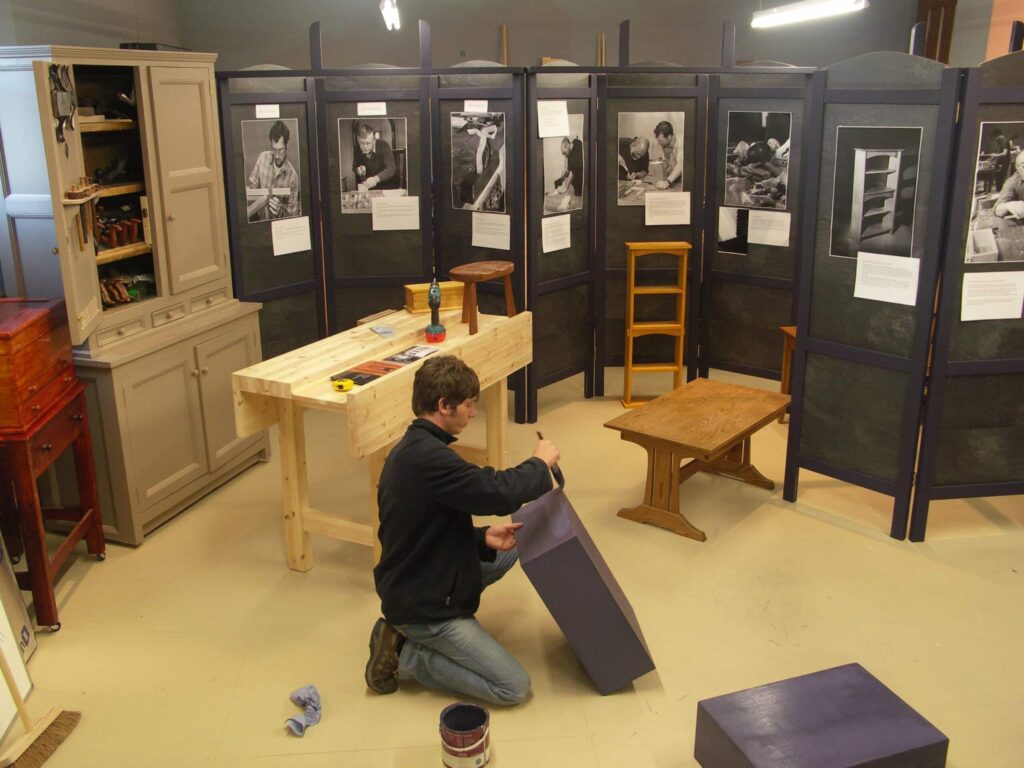
I doubt that anyone saw what was happening 40 years and more ago when woodworkers adopted machine methods on a more-than-ever-before, universal scale to actually ‘morph‘ the skills we once had to work our wood with. If or when you look back on woodworking magazines of the 1970s through the 90s, they were mostly articles about jigging and rigging up machines to replace hand skills and do different types of work to add versatility and a guaranteed outcome to the cuts made into a piece of wood; since then, of course, we have developed mostly sedentary aspects to our woodworking in the belief that ease is better than the more manual way or type of woodworking. As more resident machinist systems emerged, a completely different type of woodworking became the norm in most cultures that have nothing to do with handwork per se. Rather than the active performer of skilled workmanship through sensed contact with the wood fibres, we saw wood passed into, over and under cutterheads of different kinds that gave us near-pristine surfaces to work with and with edges all dead square and true. A skilled machinist can save hours of work truing up stock, we all know that, but the skill is not the type of dexterity handwork demands. Now it is the skill of programming, loading, and flipping, and turning wood to align with a fence guide, keeping the wood moving to avoid burn marks and steady to get that continuous cut without digs from a broken run, things like that.
But, as always, I must say that the catastrophe is not industrializing the processes of work in a home garage or shed. Far greater even than that is the sad loss of kids being with dads making things of substance with their own hands. Most dads and some mothers, a few, now place their children squarely outside the workshop doors and slam them shut! The catastrophe is not only becoming much less skilled when we could have become equally skilled but, more, that we denied children those unique and special formative years when skills are best adopted one by one and the development of sentience in working by hand becomes part of our developmental stimuli that sparks our efforts by touching every one of our 25 senses beyond the key five we are most familiar with. I cannot express the significance of this ‘something‘ that is rarely if ever really explored or mentioned anywhere in woodworking magazines of the past and, indeed, even the present.
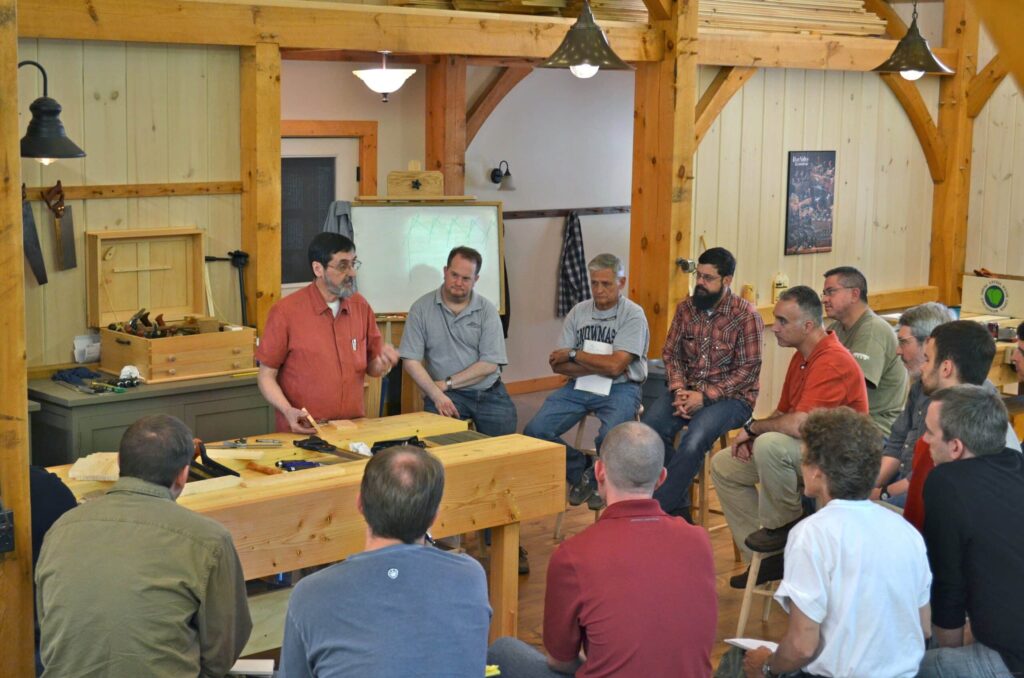
Machine methods without exception make woodworking a ‘grown-ups-only’ endeavour, and yet, with my own sons and now my granddaughter, we never turned on a machine to work with at all and we were, therefore, able to start the basics of woodworking at just three years of age. Closing the workshop doors on children is possibly the most egregious outcome of the machine-takeover thus far. We have at least two generations who never worked with hand tools and could therefore not tell their children of the benefits hand tools bring to our unique woodworking world. It is very likely that you as a reader have children and grandchildren of your own so I am hoping to nudge you not to leave it until it is too late. I have never met a child yet that wasn’t sparked into an interest in woodworking after using a spokeshave for the first time.
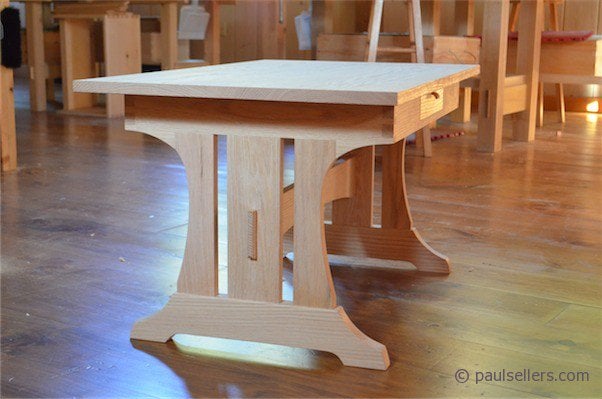
It’s not about me preserving my turf, returning to the dark ages or denying the need for speed and efficiency where needed or preferred. I don’t much care which methods people use to work their wood by but I do think it is good to sound the alarm now and then, that with a little effort we can nudge our kids off the couch, bed and chair and redirect those fingers from tapping into gripping, pushing and shoving planes and saws and chisels and spokeshaves into wood. Then too there is the added bonus of developing a nurturing environment whereby we can nurture good relationships that build and bond. I just prefer to present an alternative that truly works without me selling tools and equipment somewhere in the background. I have never once sold what I do to make money first. I do make an income, that’s a fact, but my main motive then and now has been first to make and then too to provide a way of working that is rewarding and precious and leading to an income sufficient for the needs of a family. When others said you can’t make a living your way, what they were saying was you can’t own two and three cars, a bigger house and maybe a swimming pool. That was true, but I didn’t want two cars a big house and a swimming pool anyway. I had my truck, my nice and compact home and garage workshop and the rivers and the lakes a mile or so away. This alternative often seemed to insult machinists and so-called professionals but that is mostly because I showed an alternative as the lifestyle woodworker I have always been and enjoyed.
. . . and a week later one of these!
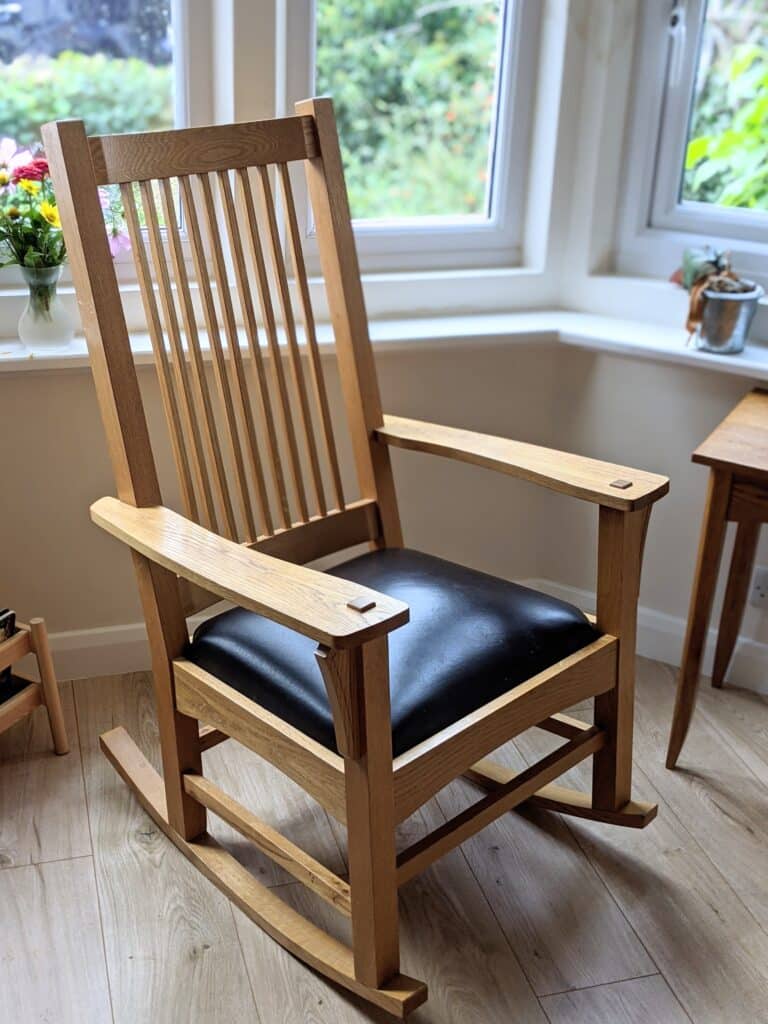
And before both of the above, you made this one below too. Machined? Nope, not one! We did start with dimensioned wood but after that, all surfaces were hand-planed, hand-sawn, and they used hand-cut joinery throughout. I know of no other woodworking course that ever achieved such outcomes in so short a time and in such quick succession like this. By the time of the rocking chair, we had concluded 24 workdays of 8-10 hours. Even colleges never achieved this in three-year-long full-time courses. What’s amazing is this though, we have now put all of these into our woodworkingmasterclasses.com offering, alongside hundreds of other courses. 25 years of my teaching became an online resource for everyone to learn woodworking. How about that!
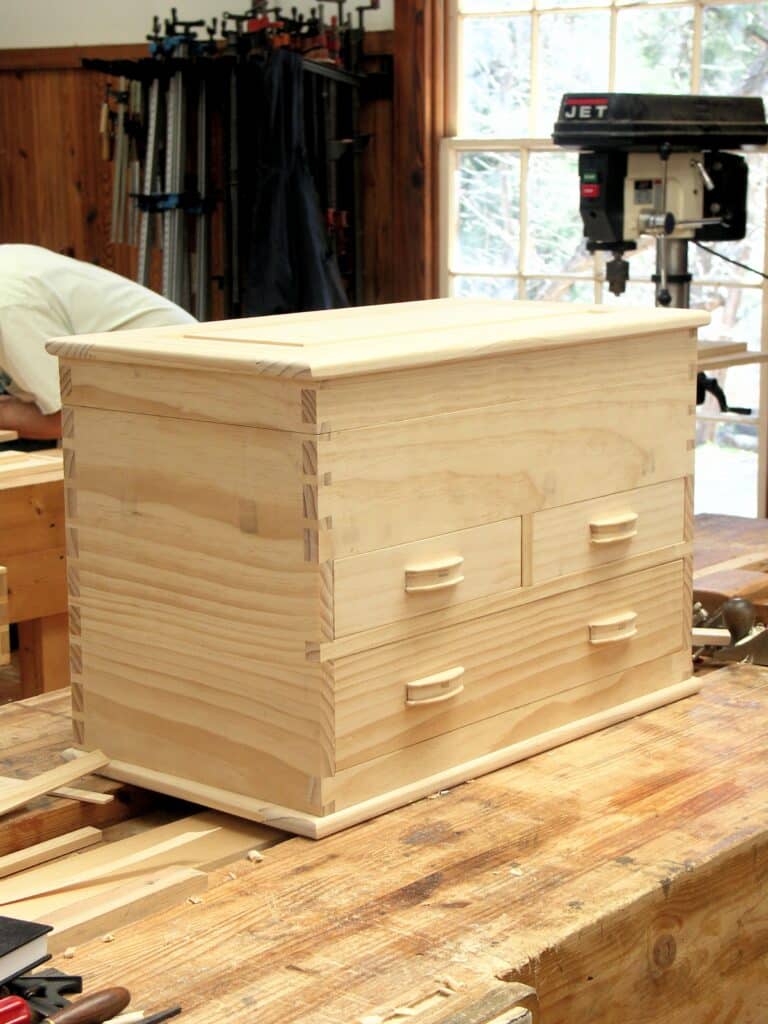


Dear Paul
I am a retired dentist and took up machine wood working in the late 70’s just as you describe. I discovered hand tool woodworking and your work 5 years ago and and was hooked and my now nearly 15 year old son started simple wood working with me and we have had a fascinating journey together. He far exceeds my ability and has built a superb tool cabinet with all hand cut dovetails, restored tools, built a 14inch wooden plane from scratch , your latest router, numerous projects from bathroom cabinets to a work bench and your work table. At the moment he is building a beautiful oak jewellery box for his mum and just loves hand tools. He can sharpen all his tools to perfection and all this thanks to your superb guidance. I must add this is made possible by him being home schooled.
So many many thanks for your vision and fantastic teaching and your fantastic production team …..Thank you again.
Phil Taylor
This is o encouraging, Phil, thank you.
Your post gives me much to look forward to. My son is three months old. In the evenings his cries cease when I take him out to the garage where we both find enrichment. He loves handling my wood folding ruler and the smells of small oak and mesquite cuttings. I’m finishing an oak stool for him to one day work from. My workbench is intentionally oversized to accommodate us both. Time will show us where our interests go.
Phil, loved your story. 40 year old dentist here just starting up the craft. Hope to teach my kids how to make and maintain stuff for themselves in the future.
Phil, you didn’t qualify at Newcastle in 1981 by any chance?! I too have followed a similar path, retiring from dentistry a few years ago and taking up woodwork. My son and partner have recently bought his first house and is now learning these skills as they embark upon a new life.
Thanks Paul for your wisdom, teaching and inspiration.
John Musgrave
Your granddaughter will not only have fond remembrances of you but will have a profound appreciation of what she can do with her own two hands. Thanks for sharing this.
Thanks Paul. Great post. I started woodworking six years ago. I had planned to fill the shop full of machine tools as I didn’t really know there was any other way. I had watched Roy Underhill on tv but didn’t realize that hand tools were still viable.
Within hours (or days at most) of discovering your YouTube videos six years ago my mind was completely changed. It eerily just clicked that I wanted to work with hand tools and at the time I didn’t understand why. Eventually realized it had to do with wanting to work with my hands and develop the skill.
My daughter was 4 at the time and she has been the shop along side me. She loved using a spokeshave. It mostly amounted to her just whittling the wood down. That was ok. No tv and in the shop with me. For her birthday’s and Christmas, I (and my dad) will buy her a few tools (often aligned with your common woodworking recommendations). Six years of this and she now has a nice tool collection that will without doubt be with her for her life. Can’t say the same for the toys she also gets.
My wife is a graphic artist and a hobby artist. As such, my daughter also paints and sculps, etc. Not sure what my daughter will want to do when she grows up but I am confident she will have hobbies she learned as a child that will allow her to do other things rather than just watch tv or be on the computer in the evenings.
I have made several dovetail joints, the first project using that joint was a tool caddy project of yours.
Since then I have made several drawers for my future kitchen, all done by hand. I have an electric router and some bits around someplace but have never used them nor do I ever intend too.
Paul, reading your experiences with woodwork machines reminded me of ripping similar sized timber on the big ripsaw with no guards during my apprenticeship as well. Also the near misses I’ve had, and heard of, in the workshop over the years.
It’s not always the machine you are working on that can be dangerous as well. While working at my bench I heard a loud bang and something wizz pass me. An off cut had jammed between the blade and fence on a drop-saw (a modern version of the swing saw you describe).
After checking that the laborer using the machine still had all his fingers (thankfully), we found the near new blade had several teeth missing or bent. The boss seemed more upset about that. Also missing was the 50 x 50 x 10 mm aluminum sacrifice fence that had sheared a 6 mm bolt. This was eventually found under a bench 15 metres (50 ft) away. That was the wizz I heard passing me. Anyone in the way of that flying shrapnel would have been severely injured at the very least.
So yes I agree hand tools are much safer than any machinery you use. Any machine (not just woodwork) you use needs to be respected and you must know how to use it properly at all times.
Hello,
I have two girls, and they are both in their forties. When they were very young children we used to fly those small rubber band powered planes together. We learned that when you run into the wind just as you are launching them they will go far up into the air and fly wistfully in the breeze, and a couple times we had amazing perfect landings. A little later we started to build our own rubber band powered planes out of balsa wood and paper, the trouble is they don’t land well. It was great fun working together at the kitchen table. Of course being girls we next had to build wooden dollhouses together. At the time I was not involved with hand tools but the joy of teaching my children how to use the tools we had is long lasting. We also have always done outdoor things as a family too. Now my oldest daughter has taken up mountain hiking and snowshoeing, and has drawn my wife and myself to share in her easier trips, so I now have a new set of snowshoes! Our family is still an attached unit and for this I am most surely happy. I have introduced one of my daughters to my new hand tool workmanship and she likes what she sees. Both will tackle projects of their own because of what they have learned from their parents. I am indebted to Paul because he has helped me to expand my horizons but it is because of my interest in our creator that I have been able to have such a strong family, and a sure hope that in the near future everyone on this place we call home, earth; that all people on all continents can have a shot at a joyful life, and to be sure hand tool workmanship, of all types, will flourish.
Wonderful article Paul. I’m 65 years old and started building furniture by hand one year ago. I hadn’t built anything since my last year of high school shop, more than 45 years ago. You videos and articles are an inspiration to me. And I agree that working in the shop is both a physical and mental workout that renews the soul. Thank you.
The picture of Marco, (yes that’s his name) sitting in front of the CNC router is bittersweet. You see, I have worked for that company for over 20 years now. Before that I worked in cabinet shops and worked my way into the engineer dept. When we started with a CNC back in 1995, it was to open up new possibilities. Sadly, that changed over the years. It has devolved into a numbers game, machines are cheaper than people now. They show up on time everyday, and don’t take breaks. And, now they don’t really need operators anymore in many cases. Unlike in the beginning, todays operators now are usually poorly paid, and poorly trained. Rarely do you see an operator who will take ownership of the machine and care for it and learn everything about it. And now when a machine breaks, the vast majority of users do not know how to fix them, and worse yet they can’t do the work by hand. Now a days I am working from my home office doing technical support dealing with a work force who is in no way prepared for a machine to break (and all machines eventually break). So, I have spent the last year turning my garage into a woodworking shop (a no CNC zone). Hand tools seem to release the stress caused by dealing with those stressed out customers who expect miracles over the phone. I love my job, and like helping people, but it is sad to see what skills have been lost over the years.
Thanks Rob. I never imagined anyone would actually make any connection.
Dear Paul
I discovered you by accident on youtube, there are so many ” easy” videos e.g. how to make a beginners wood lathe For only a hundred dollars , they then show you a 500sqft workshop with cnc and industrial everything probably costing more than 30k ! The camera is bouncing up and down , wild zooming , BAD music and some manic guy who shouldn’t operate machinery. Im 61, I’m a beginner , i feel i have some potetial but not the skills, your videos are a breath of fresh air, a well lite shop, well positioned cameras that keep still ! No zooming , no music, just a calm and skilled carpenter giving clear instructions using hand tools ! I am making your ” poor mans spoke shave ” . In have tinnitus and find the “noise pollution ” which is so common now very annoying . Hence I enjoy hand tools because they are quieter. Thankyou for your excellent videos.
Louis showell.
I recently had to make the decision between replacing my old and unused power router and bits, or just taking the time to source a Record 043, Stanley 78 and a Veritas router plane. I realized the need to make some rebates, plow some grooves and all in the least amount power tools would demand. I was so glad to take your advice and have yet to regret the new to me hand tools. They are nicer, were much cheaper in cost and make lovely shavings as opposed to dust and the screaming noise of their electric motors. Thank you once again for having given the rest of us an alternative to the usual fare on offer here in the US. Not only that but you give us the courage to branch out and try something from the path most traveled.
I’m 42 and have recently started wood working to revive my younger days of building something with my two hands. I’ve come to realize how much I enjoyed and was able to focus on the build task for hours. As a beginner, all I had was some basic tools. I found an older gentleman selling old rusty tools and started from there. Within a year of furiously watching your classes, I have now built wife’s desk, kitchen table, coffee table, and now a cabinet.
The best item I made was a keep sake box with a music player for my 8th birthday. To be able to make something that can last a life time is mind boggling. All of this I’ve made was done using, mostly your techniques. They simply work. I am grateful for your passion in showing the world that basic tools are all you need. Plane, saw, chisel or two… beautiful.
Both my kids want to join me in making something and was wondering what “projects” are good for young kids. Unfortunately, I do not own a spokeshave but have some planes and saws. Any suggestions or ideas would be much appreciated as I too want them to believe that they can create something from nothing.
Many blessings from Canada.
Gracias a ud. Paul, al ver sus videos me enganché igual con la carpintería a mano, hoy tengo el orgullo de decir que he hecho varias cajas para mis set de ajedrez con mis propias manos. El placer de sentir la madera es indescriptiblemente placentero, perforar con taladros manuales, cepillar, aserrar con serrucho…todo un arte. Muchas gracias Paul.
Thank you Carlos. Very kind.
For those reading, here is the translation:
Thanks to you. Paul, when I saw your videos, I was equally hooked on carpentry by hand, today I am proud to say that I have made several boxes for my chess sets with my own hands. The pleasure of feeling the wood is indescribably pleasant, drilling with hand drills, planing, sawing with a handsaw … an art. Thank you very much Paul.
Hi Paul
Once working in a large commercial workshop i was told about somebody who worked there how he lost is fingers. He was using a Spindal moulder and inside the wood he was machining there was a Thunder shake which caused the wood to break and his finger went in to the cutters.
About teaching children .My son was about eleven and one winter we made a bird table i showed how to use the tools to make it and before he left home and got married we spent hours sharing the same space he was making is own things and i making my ow. Now he works for himself restoring boats in the Lake district . I feel proud that i sowed a seed for him to enjoy woodwork and working with his hands. So dads and Mums don’t shut your children out when they want to learn woodworking. I was Ten when i started my love of woodwork. It started with a joinery in my village he employed several joiners even though they had some basic machines a lot of the work was by hand to a very high standard because there was a lot of hand work i would stand at the end the bench and watch and they would show and tell me how to do things . In time i would do small jobs. If that joiner had not taken time to show me things my love of woodwork might have not lasted but it did and fifty four years i am still doing and learning woodwork.
Hi Paul,
I’ve enjoyed your writing as usual 🙂
Only yesterday a workmate found out about my love for woodworking (I’m always talking about to anyone who want hearing), and when he recommended me to see so-and-so’s YouTube videos, I had a glance at it and saw 4 out of 5 of his most popular videos shown him grabbing one or another power tool …so I grabbed your name from Wikipedia and sent it back saying “I appreciate your appreciation for woodworking, e hoa, but my chap Mr. Sellers eats So-and-so’s types for brekkie” …it was cheeky, but we had a laugh and he admitted I was probably right after reading your intro. By the way, you’re firstly introduced as a writer there, so no surprises this here has good read.
Lastly I wanted to say that reading the title here my heart skipped a bit – I thought you’d be covering all about metal plough planes!!! Please don’t, not until you give birth to “the best plough plane in the world”, I beg. I’m yet to own a plough plane, and I’d like the price to not skyrocket, thanks.
😉
Thank you for your inspiring thoughts.
Paulo
Hand tools can do whatever machines can, it just takes longer.
However, what machines can’t do that hand tools can and do is provide quiet, and an opportunity to ponder whilst working (unless you have digits you don’t need).
When I did my trade as cabinet maker in the late 70’s it comprised of cabinet making, wood machining and French polishing as part of the trade.
Stupidly, I eventually left the trade and did 2 metal trades, but hand tool woodworking has always been my first love and where I go to find solace when life is getting on top of me.
It saddens me when I see young people go straight to machines now days rather than learning hand tool skills, and call themselves woodworkers.
I suppose loosely they are, but…..
It’s not archaic to use hand tools as many ignorant YouTubers state, it’s an essential skill.
What do they do in the case of a blackout?
I’ve got numerous machines that I’ve acquired over many years, but what I can do on the machine I learned to do by hand first, and still can.
Now I’m approaching retirement after over 40 years in a noisy environment, my focus is going back to my first love.
Will I get rid of most of my machines?
Eventually: after a lifetime of working against the clock in a noisy environment, that’s the last I want when I retire.
I really won’t need a jointer, a table saw and thicknesser just to dimension a piece of timber quickly.
So what if it takes me an extra 10 minutes by hand; I’ll be retired.
I truly understand anyone’s reluctance to get rid of their machines once they have become used to them. A jointer and planer gives great flatness in a matter of minutes and then the parallel cut halves the work remaining. I get that. It’s discou8nting all else that has so bugged me through the years. Children not woodworking, deskilling the whole world of woodworking, the dangerous elements that are constantly there and that can never be ignored. What of pollution of the atmosphere, which needs noise eyesight and long protection constantly. All magazines for decades to date have shown images of machine woodworkers in such dangerous environs with little or no personal protection at all. Giving the image of a kind of connectivity to the work that actually is not there. I am working on an article about the various therapies resulting from hand work. I think it will be interesting.
Lovely article Paul.
I’m 39 and have a boisterous 4 year old who lives life at 100mph and struggles to concentrate at home.
I think a spokeshave might be a great present for us to both learn woodworking with.
Thank you.